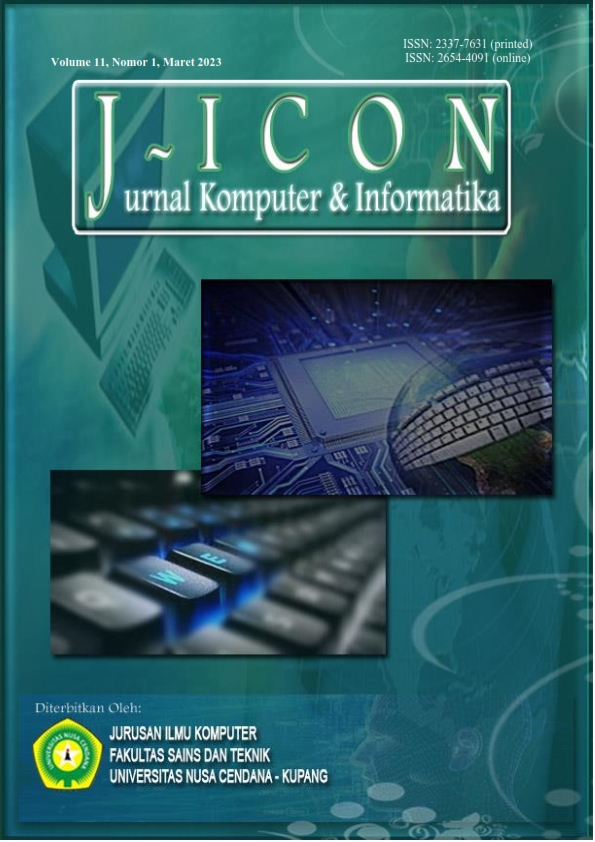CLASSIFICATION OF INTERNET TRAFFIC DATA USING SUPPORT VECTOR MACHINE ALGORITHM
Abstract
It is undeniable that nowadays, the internet is essential for various needs. STMIK Widya Cipta Dharma is no exception. The internet is widely used in the campus environment by students, lecturers and education staff. Teaching and learning activities and work in the campus environment are inseparable from the need to use the internet. However, internet usage time sometimes accumulates in certain hours and causes slow internet speeds. This is influenced by the large number of header packets sent in the internet traffic flow, so the connection becomes heavy and feels sluggish. Therefore, a classification method is needed to provide information about the activities of students, lecturers and academic staff using the internet. The classification algorithm used is the Support Vector Machine (SVM). The development method used is SKKNI Number 299 of 2020. The parameters used are the flow of packets sent by the user and packets received by the user. The results of this study are in the form of an SVM algorithm model that can classify current internet traffic usage into four categories, namely Download, Game, SocialNetwork, and Web, which has an accuracy of 64% using the Radial Basis Function (RBF) kernel. The resulting accuracy results are pretty low and make the SVM algorithm unsuitable for classifying internet traffic and the need for other methods to classify internet traffic.
Downloads
References
S. Riyadi, “Penerapan Metode Naive Bayes dalam Pengklasifikasi Trafik Jaringan,” SMATIKA Jurnal, vol. 6, no. 2, p. 29, 2016, doi: 10.32664/smatika.v6i02.45
N. Al Khater and R. E. Overill, “Network traffic classification techniques and challenges,” in 2015 Tenth International Conference on Digital Information Management (ICDIM), Oct. 2015, doi: 10.1109/ICDIM.2015.7381869.
M. J. Zaki and J. W. Meira, Data Mining and Analysis. Cambridge University Press, 2014. doi: 10.1017/CBO9780511810114.
E. Prasetyo, Data Mining : mengolah data menjadi informasi menggunakan Matlab. Yogyakarta: Andi, 2014.
Suyanto, Data mining : untuk klasifikasi dan klasterisasi data. Bandung: Penerbit Informatika, 2017.
R. R. R. Arisandi, B. Warsito, and A. R. Hakim, “Aplikasi Naïve Bayes Classifier (Nbc) Pada Klasifikasi Status Gizi Balita Stunting Dengan Pengujian K-Fold Cross Validation,” Jurnal Gaussian, vol. 11, no. 1, pp. 130–139, May 2022, doi: 10.14710/j.gauss.v11i1.33991.
T. Kurniawan, “Implementasi Text Mining Pada Analisis Sentimen Pengguna Twitter Terhadap Media Mainstream Menggunakan Naïve Bayes Classifier dan Support Vector Machine,” Skirpsi Institut Teknologi Sepuluh Nopember, Surabaya, 2017.
M. Nishom, “Perbandingan Akurasi Euclidean Distance, Minkowski Distance, dan Manhattan Distance pada Algoritma K-Means Clustering berbasis Chi-Square,” Jurnal Pengembangan IT (JPIT), Vol. 4, No. 1, pp. 20–24, Jan. 2019, doi: 10.30591/jpit.v4i1.1253.
N. Hadianto, H. B. Novitasari, and A. Rahmawati, “Klasifikasi Peminjaman Nasabah Bank Menggunakan Metode Neural Network,” Jurnal Pilar Nusa Mandiri, vol. 15, no. 2, pp. 163–170, September 2019, doi: 10.33480/pilar.v15i2.658.
N. A. Rakhmawati, D. B. Aletha, L. P. G. Widiastuti, A. S. Laka Kaki, and A. T. Aminullah, “Klasterisasi Peraturan Daerah di Seluruh Wilayah Jawa dengan Menggunakan Algoritma K-means,” Jurnal Sisfokom (Sistem Informasi dan Komputer), vol. 9, no. 2, pp. 242–246, Juli 2020, doi: 10.32736/sisfokom.v9i2.816.
Z. Aouini and A. Pekar, “NFStream,” Computer Networks, vol. 204, Februari 2022, doi: 10.1016/j.comnet.2021.108719.
Copyright (c) 2023 Pitrasacha Adytia, Wahyuni Wahyuni, Kelik Sussolaikah, Yudha Satria

This work is licensed under a Creative Commons Attribution 4.0 International License.
The author submitting the manuscript must understand and agree that if accepted for publication, authors retain copyright and grant the journal right of first publication with the work simultaneously licensed under a Creative Commons Attribution (CC-BY) 4.0 License that allows others to share the work with an acknowledgment of the work’s authorship and initial publication in this journal.
 Pitrasacha Adytia(1)
Pitrasacha Adytia(1)




